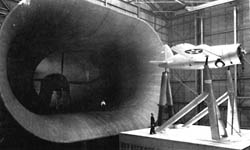
Almost all high performance aircraft used by the United States before and during World War II were tested at the Full Scale Tunnel at the Langley Research Center in Virginia. By 1929 the National Advisory Committee for Aeronautics (NACA) wind tunnel complex at Langley was completed and producing useful high quality aerodynamic research data, but NACA engineers realized there was a gap in their wind tunnel inventory--a full scale wind tunnel. The design of the Full Scale 30- by 60- Foot Tunnel began in 1929 under the leadership of Smith J. De France. With funds having been appropriated before the start of the Depression, NACA was able to buy materials at bargain prices and utilize talented, unemployed aeronautical engineers. Work on the Full Scale Tunnel progressed quickly and by 1931 the tunnel was complete. Soon a large procession of military aircraft was dispatched to Langley for drag cleanup tests.
During most of World War II the Full Scale Tunnel at Langley, the only tunnel in the world capable of performing these tests, operated 24 hours a day, seven days a week. In recent years the Full Scale Tunnel has tested aircraft such as the Harrier VTOL fighter, the F-16, the American supersonic transport, the Space Shuttle and the Lunar Landing Vehicle. In 1995, the National Aeronautics and Space Administration (NASA) terminated its operations at the Full Scale Tunnel and turned the facility over to Old Dominion University for use as an engineering research laboratory.
Visit the National Park Service Travel American Aviation to learn more about Aviation related Historic Sites.
Last updated: August 29, 2017
